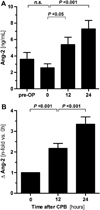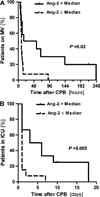Angiopoietin-2 is a potential mediator of endothelial barrier dysfunction following cardiopulmonary bypass
- PMID: 22770562
- PMCID: PMC4127984
- DOI: 10.1016/j.cyto.2012.04.002
Angiopoietin-2 is a potential mediator of endothelial barrier dysfunction following cardiopulmonary bypass
Abstract
Introduction: Endothelial activation leading to vascular barrier dysfunction and organ failure is a well-recognized complication of cardiovascular surgery with cardiopulmonary bypass (CPB). The endothelial-specific angiopoietin-Tie2 ligand-receptor system has been identified as a non-redundant regulator of endothelial activation. Binding of angiopoietin-2 (Ang-2) to the Tie2 receptor antagonizes Tie2 signaling and renders the endothelial barrier responsive to pro-inflammatory cytokines. We aimed to study the time course and potential triggering factors of Ang-2 release after CPB, as well as the association of Ang-2 changes with surrogates of increased vascular permeability, organ dysfunction, and outcome.
Methods: Serum levels of Ang-2 from 25 adult patients (140 screened) were measured before and at 0, 12, and 24h following CPB procedure by in-house immuno-luminometric assay (ILMA), and compared with indices of organ dysfunction, duration of mechanical ventilation (MV), length of stay (LOS) in the intensive care unit (ICU), and hospital mortality. The effect of Ang-2 was studied in vitro by incubating high Ang-2 patient serum with endothelial cells (EC).
Results: Ang-2 levels steadily increased from 2.6 ± 2.4 ng/mL at 0 h up to 7.3 ± 4.6 ng/mL at 24h following CPB (P<0.001). The release of Ang-2 correlated with the duration of CPB, aortic cross-clamp time, and post-CPB lactate levels. Changes in Ang-2 during follow-up correlated with partial pressure of oxygen in arterial blood (PaO(2))/fraction of inspired oxygen (FiO(2)) ratio, alveolar-arterial oxygen tension difference (AaDO(2)), hemodynamics, fluid balance, and disease severity measures. Ang-2 levels at 12h predicted the duration of MV, ICU-LOS, and hospital mortality. High Ang-2 patient sera disrupted EC architecture in vitro, an effect reversed by treatment with the competitive Tie2 ligand angiopoietin-1 (Ang-1).
Conclusions: Collectively, our results suggest that Ang-2 is a putative mediator of endothelial barrier dysfunction after CPB. These findings suggest that targeting the Ang/Tie2 pathway may mitigate organ dysfunction and improve outcome in patients undergoing CPB.
Copyright © 2012. Published by Elsevier Ltd.
Figures




References
-
- Aird WC. Endothelium as an organ system. Crit Care Med. 2004;32:S271–S279. - PubMed
-
- Boyle EM, Jr, Pohlman TH, Johnson MC, Verrier ED. Endothelial cell injury in cardiovascular surgery: the systemic inflammatory response. Ann Thorac Surg. 1997;63:277–284. - PubMed
-
- Wan S, LeClerc JL, Vincent JL. Inflammatory response to cardiopulmonary bypass: mechanisms involved and possible therapeutic strategies. Chest. 1997;112:676–692. - PubMed
-
- Aird WC. The role of the endothelium in severe sepsis and multiple organ dysfunction syndrome. Blood. 2003;101:3765–3777. - PubMed
-
- Asimakopoulos G, Smith PL, Ratnatunga CP, Taylor KM. Lung injury and acute respiratory distress syndrome after cardiopulmonary bypass. Ann Thorac Surg. 1999;68:1107–1115. - PubMed
MeSH terms
Substances
Grants and funding
LinkOut - more resources
Full Text Sources
Miscellaneous

